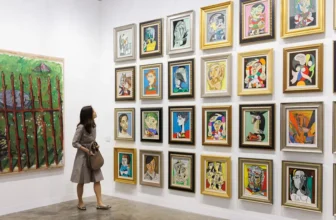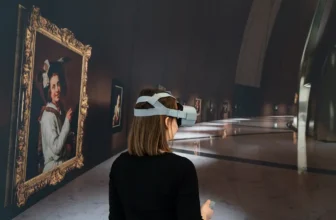The Mystery and Meaning of Monomaniac of Envy
The French Romantic painter Théodore Géricault (1791–1824) is often remembered for his monumental canvas The Raft of the Medusa (1818–19), a raw depiction of human suffering, desperation, and survival. But beyond his grand historical works, Géricault also pursued a profoundly psychological project: a haunting series of portraits of individuals afflicted with mental illness. Among these works, one painting stands out as particularly enigmatic and disturbing: Monomaniac of Envy.
Unlike his more public works, this portrait was not commissioned for broad audiences but created as part of Géricault’s personal and experimental investigations into the human psyche. The Monomaniac of Envy painting captures an anonymous figure whose identity and story remain cloaked in mystery. Why was it painted? What exactly does it represent? And what deeper meaning lies behind its shadowed face and penetrating gaze?
To understand the painting fully, one must look at its artistic qualities, its medical and historical context, and its symbolic weight within the Romantic era.
Who Painted Monomaniac of Envy and Why?
The artist behind this unsettling masterpiece, Théodore Géricault, was a leading figure of early French Romanticism. Unlike his predecessors who sought beauty, balance, and idealized form, Géricault gravitated toward themes of extremity: insanity, crime, suffering, and the fringes of human experience.
After completing The Raft of the Medusa, a painting that had stirred both praise and controversy, Géricault embarked on a lesser-known project in collaboration with the psychiatrist Dr. Étienne-Jean Georget, one of the pioneers of early psychiatry in Paris. Georget, who was deeply interested in the classification of mental illnesses, commissioned Géricault to paint a series of portraits of patients at the Salpêtrière asylum.
Each portrait was meant to represent a specific form of mental disturbance, then known as “monomania.” Monomania was an early psychiatric term for a mental disorder in which a patient was obsessed with one overriding idea or emotion, such as jealousy, theft, or gambling, while otherwise appearing sane.
Monomaniac of Envy was one of these portraits. It was intended to visually document the facial expressions and bearing of an individual consumed by pathological envy.
Why Is the Monomaniac of Envy Painting a Mystery?
The mystery of Monomaniac of Envy lies in several unresolved questions:
The Identity of the Subject – We do not know who the sitter was. The patient’s name was not recorded, and no details of their life or condition have survived. They remain an anonymous emblem of envy rather than a distinct person.
The Purpose of the Series – While Géricault’s collaboration with Dr. Georget is historically documented, it is unclear whether the portraits were intended strictly for medical study, for private artistic exploration, or as both. The boundary between science and art blurs in these works.
The Number of Paintings – Historians debate how many portraits were painted. Some suggest around ten; others claim as few as five. Only five authenticated works survive today, including Monomaniac of Envy.
The Fate of the Series – After Géricault’s death at the age of only 32, many of his works were scattered. The psychiatric portraits, lacking the grandeur of The Raft of the Medusa, slipped into obscurity for decades. Monomaniac of Envy resurfaced much later, further deepening its aura of mystery.
Thus, while the painting is rooted in psychiatry, its aura goes far beyond science. It is not simply documentation but also a profound and unsettling psychological portrait that resists simple explanation.
What Is Happening in the Monomaniac of Envy Painting?
Monomaniac of Envy shows a half-length portrait of a solitary figure. The subject’s body is slightly turned, the head tilted downward, and the eyes fixed in a brooding, inward stare. The clothing is plain, almost monk-like, with muted brown and gray tones. The light strikes the face from above, accentuating its gauntness and furrowed features.
What makes the painting powerful is the expression. The sitter’s mouth is tense, the lips pressed together in a way that suggests suppressed bitterness or resentment. The eyes, dark and hollow, seem to look not outward but inward, as if consumed by hidden thoughts. Unlike portraits of aristocrats or heroes, there is no grandeur here, only an oppressive psychological atmosphere.
The subject does not act, does not move, and yet everything about the painting vibrates with restless inner turmoil. The viewer is left with the impression that envy is not merely an emotion but an entire condition that eats away at the individual.
What Does Monomaniac of Envy Represent?
At its core, the painting is not just about one patient, it is about the human condition.
Psychological Portraiture: It represents an early attempt to capture mental illness not through caricature but through realism. Unlike earlier depictions of “madmen,” which were often grotesque or exaggerated, Géricault paints the subject with dignity, restraint, and compassion, even while emphasizing their torment.
Romantic Fascination with Madness: In the Romantic era, madness was often seen as both terrifying and alluring, a window into the extremes of human existence. Géricault’s work reflects this fascination, treating envy as a force that consumes and isolates.
Universal Symbol of Envy: On a symbolic level, the painting transcends psychiatry. The anonymous face becomes a metaphor for envy itself, a corrosive emotion that diminishes joy and breeds alienation.
Monomaniac of Envy Symbolism and Meaning
The symbolism in Monomaniac of Envy is subtle, residing not in props or allegorical objects but in the expression, lighting, and pose.
Lighting: The face is illuminated while the background remains in shadow. This contrast can be read as a metaphor for the struggle between inner darkness and outward visibility.
The Eyes: The subject’s gaze is not direct but downward and sideways. It suggests secrecy, watchfulness, and the inability to meet others openly, hallmarks of envy.
Clothing: The drab, almost monastic garments strip away individuality. The sitter is not defined by social status but by inner affliction.
Pose: The inward-turning posture and tense features convey the isolating nature of envy, an emotion that turns individuals against others and ultimately against themselves.
The painting thus becomes more than a clinical study. It is a meditation on envy as a destructive and universal human force.
What Type of Art Is Monomaniac of Envy?
Stylistically, Monomaniac of Envy belongs to the Romantic movement, but it also carries elements of realism and psychological portraiture that anticipate later developments in art.
Romanticism: Like other Romantic works, it explores the extremes of emotion, the darker sides of human experience, and the sublime power of psychological states.
Realism: The portrait is stripped of idealization. It depicts wrinkles, sagging skin, and imperfections with unflinching accuracy.
Psychological Realism: Perhaps most importantly, it marks an early attempt to represent psychological reality in art. In this sense, Géricault prefigures later artists such as Van Gogh, Munch, and the Symbolists, who also painted inner turmoil.
Where Is Monomaniac of Envy Today?
Today, Monomaniac of Envy is housed in the Musée des Beaux-Arts in Lyon, France. It stands alongside several other surviving portraits from Géricault’s “monomaniac” series, including The Monomaniac of Theft and The Monomaniac of Gambling.
The painting is preserved as both an artwork and a historical document, bridging the worlds of fine art and early psychiatry. Visitors encounter it not only as a visual object but also as a portal into 19th-century understandings of the mind and into the Romantic obsession with the margins of experience.
The Eternal Mystery of Envy
Théodore Géricault’s Monomaniac of Envy is at once a portrait, a medical study, and a symbolic representation of one of humanity’s most corrosive emotions. It remains a mystery because its subject is unknown, its purpose straddles the line between science and art, and its emotional force resists easy explanation.
The painting forces us to confront envy not as a passing feeling but as an all-consuming state of being. It suggests that envy is not just a moral flaw but a psychological imprisonment, a shadow that isolates, corrodes, and erodes the human spirit.
In capturing this, Géricault achieved something profound: he gave a face to one of humanity’s darkest impulses. And in doing so, he created a work that continues to unsettle, fascinate, and challenge us two centuries later.




